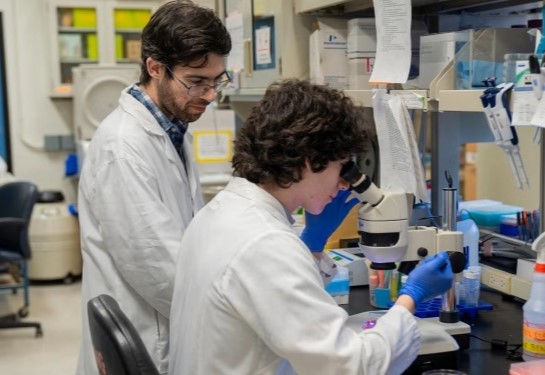Class of 2026 honored at School of Medicine Induction program
White coat ceremony celebrates “talents and abilities” of 133 new students
The 133 students inducted into the UC Davis School of Medicine over the weekend received encouraging words from a doctor who once sat in their place.
“Today you get to start anew. Forget your GPA. Forget your MCAT score. All that is in front of you now is uncapped potential,” said Elise Boykin-Harris, keynote speaker and 2018 graduate.
“So class of 2026, you were chosen to be at UC Davis for a reason: We see the potential in you. All of your talents and abilities and what you uniquely bring to the world of health care and to your patient experiences.”
Boykin-Harris’ message was a highlight of the annual ceremony where the incoming class, each of its members dressed in a new, white lab coat, is officially welcomed to the School of Medicine.
This was the first ceremony since 2019 that was held before an audience of hundreds of loved ones in Mondavi Center for the Performing Arts in Davis, who clapped hands, snapped photos and shed tears of joy. In an obvious sign that the pandemic is not over, each student sat on stage wearing a blue face mask covering their mouth and nose.
.jpg)
“Today marks an exciting milestone,” said Hendry Ton, UC Davis Health associate vice chancellor for Health Equity, Diversity and Inclusion. “Your journey in this moment was hard earned.”
Ton told students that they have been, are and will be “a force for good – and now, a source for healing.”
Another speaker, fourth-year student Samya Faiq, asked students to wave at their supporters in the audience, calling them “members of your village who helped you get a seat today on this stage.”
Then she cautioned that over the next four years, students will, at times, feel distanced from their loved ones. “At these times,” she told the students, “I implore you to look to your right and left, because these will be some of the members of your new village.”
Faiq also said students will soon start to speak a language that’s vastly different to the ones they already know: “Medial epicondyle instead of funny bone. Or, open reduction internal fixation instead of, just pop that dislocated hip back into place.”
The Class of 2026 once again celebrates diversity.
Half of the 133 students belong to groups that are under-represented in medicine, including 40 who identify as Hispanic/Latinx, 18 who are African American and 4 who are American Indian/Alaska Native.
Two students are classified under federal government terminology known as DACA (Deferred Action for Childhood Arrivals). It generally means the students were brought to the United States as children with undocumented parents and are protected from deportation as long as the government’s temporary relief continues to exist.
In another emerging trend over the decades, women make up 60% of the class.
For many students, the most meaningful part of the ceremony was hearing their names called out loud, signifying it was time to march across the stage so a dean could place a stethoscope around their shoulders. It’s a ritual at induction, which is also known as a white coat ceremony.
And in part, the ritual resembled a graduation with clapping and whooping as students crossed the stage.
Once everyone received a stethoscope, selected students read the medical student pledge of ethics in the language represented by their cultural heritage.
The entire class then recited the oath in English.
Students walked off the stage and through the exits the same way they entered – to the sounds of family members cheering and the beat of Japanese Taiko drumming.




